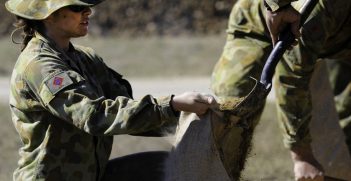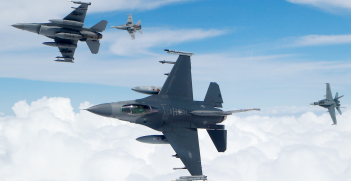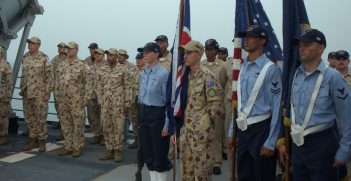"How to Defend Australia" Is an Important Wake-up Call

Hugh White should be praised for getting Australians to think the unthinkable and alerting them to our deteriorating strategic situation, questions about the reliability of US security assistance and the need to get on better with our neighbours.
Since the advent of Donald Trump as US president, the certainties that are said to underpin Australia’s defence doctrine are less convincing than ever. Trump’s cynicism about alliances underlines the fact that ANZUS is no longer — if it ever was — a guarantee of American military assistance. Neither Prime Minister Morrison posing on the deck of the USS Ronald Reagan during the latest Exercise Talisman Sabre in July 2019 nor the promise of a state dinner in Washington dispel this uncertainty. They do however increase pressure on Morrison to commit the ADF to join the United States in a war against Iran or take a more robust stand against Chinese encroachment in the South China Sea if asked, as he is likely to be.
Hugh White’s book is therefore timely. It is an honest attempt by a former senior defence bureaucrat to assess whether Australia can and should defend itself with its own resources. He recalls a succession of past Defence White Papers that have toyed with the possibility of Australian self-sufficiency but invariably concluded that we have no defence against a determined big power and must fundamentally rely on the United States and the ANZUS Treaty.
Not only is such reliance now suspect but the strategic situation has moved against us. Where once we could rely on the presence of the United States in the region to “keep the peace” — a very contentious assertion — we now see a diminution of US power. Where once we enjoyed technical superiority in weaponry over our neighbours, we now see technical parity. Where once we needed to consider the possibility of conventional war against other states, we now also have to consider asymmetrical conflict with non-state antagonists with cyber as well as kinetic warfare capabilities.
In such a deteriorating situation, White asks if Australia can realistically defend itself. He gives a qualified “yes,” depending on who is going to attack us. But, he says, to do so we must plan carefully, deliver what we need efficiently and spend at least double the $36 billion we allocate each year to defence.
For a start, we must stop wastefully indulging in foreign adventures on behalf of the United States in return for security it may or may not provide. We should have learned the lesson in World War II when Churchill promised Australia naval protection against Japan in exchange for three infantry divisions to fight Rommel at El Alamein. Since then, driven by an equally dubious hope that the United States will defend us against an attacker, we have supported US military adventures in Asia, Africa and the Middle East.
Instead, says White, we must follow a hard-headed approach. The first two stages of which are to deny our immediate maritime and air approaches to potential enemies, and cultivate support for our strategic interests among the governments of the island countries to our immediate north.
In realising these aims, our acquisition of giant C-17 long-range transport aircraft and Canberra-class amphibious ships for force projection has been a waste of money. So has the acquisition of expensive and ever-larger surface vessels like air warfare destroyers of which we could only afford a few, and which are vulnerable to submarines and missiles. Inter-operability with United States forces would become irrelevant.
Instead, says White, we would have to concentrate on defending our own backyard. To deny our air approaches to an enemy we must be equipped with large numbers of fighter aircraft linked to drones, satellites and missiles. Seventy-five fifth-generation F-35 fighter aircraft is a start, but many more are needed. And we need also to deny our sea approaches with many modern submarines than we have at present. Six aging Collins class boats, to be replaced around the 2030s by 12 French Shortfin Barracudas, will not be enough. We need a fleet of around 24 state-of-the-art submarines, and we need them quickly.
White admits that even such weaponry will not defend us from an attack from a major power determined to invade us, such as China. To do that, he asserts that Australia would have to at least consider acquiring a nuclear deterrent.
But what he does not say is that to do so would mean abandoning our non-proliferation credentials, which would create an immediate regional backlash. Some neighbours such as Indonesia would actively consider acquiring nukes of their own. The region would become a more dangerous place. Nor does he consider in detail how we could acquire the technology. Even if we could expand existing enrichment technology at Lucas Heights to produce highly enriched uranium 235 and construct our own nuclear warheads, White calculates that we would need at least four nuclear-powered submarines carrying sea-launched ballistic missiles to deliver them. The cost would be enormous and neither the United States nor other nuclear weapon states would be likely to sell us such sensitive technology.
Above all, we would become a compelling target for a nuclear strike from existing nuclear weapon states. Not that we are not one already. With its missile and drone guidance technology, Pine Gap must already be an inviting contingency target for Chinese or Russian nuclear missiles in the event of nuclear war with the United States.
Leaving aside the nuclear option, could Australia do all that we need for credible independent defence? White says we could. We have the technology, the wealth and the population, although a bigger economy would help. But it would all cost. To acquire the 200 fighter aircraft and 24 submarines necessary for credible air and sea denial we would have to increase our annual defence expenditure from just under 2 percent to around 3.5 percent of GDP. Nor should we try to make weapons ourselves. We can never become the major weapons-exporting country former Prime Minister Malcolm Turnbull notoriously claimed we could, and buying proven technology off-the-shelf from other countries would be far more timely and cost-effective.
Hugh White should be praised for getting Australians to think the unthinkable and take a realistic look at our defence situation. Much of the landscape is unpalatable and his arguments will no doubt be picked apart by those politicians and conservative think-tank leaders who cling to the American security blanket as an excuse for not spending more on defence. But in my view it is a wake-up call, alerting Australians about our deteriorating strategic situation, the increasing unreliability of US security assistance and the need to take a greater effort to get on better with our neighbours through diplomatic means.
Richard Broinowski AO is the immediate past president of AIIA NSW and a frequent commentator on public affairs on radio and television. He has served as Australian Ambassador to Vietnam, Republic of Korea, Central American Republics and Cuba.
This article is published under a Creative Commons Licence and may be republished with attribution.





